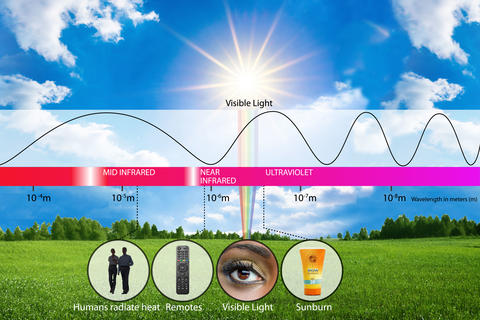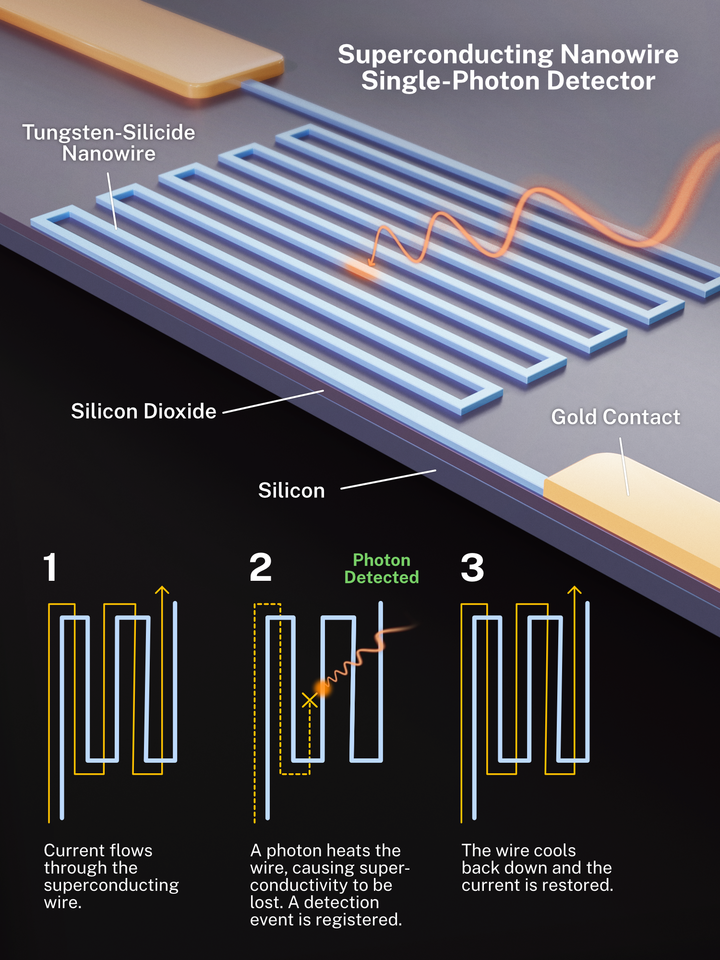Detecting mid-infrared light, one photon at a time
Chilled superconducting nanowires may heat up the search for chemical signs of extraterrestrial life and allow military vehicles to navigate at night unnoticed.

For some 30 years, scientists have used superconducting materials to record the tiniest specks of light imaginable — individual photons, or single particles of light. However, these detectors, which consist of ultracold wires only about one-thousandth the diameter of a human hair, were limited to recording single photons at visible-light and slightly longer wavelengths, in the near infrared (IR).
By altering the composition of these nanowires, researchers at the National Institute of Standards and Technology (NIST) and their colleagues have now demonstrated that the devices can efficiently record single photons that have wavelengths up to 10 micrometers (millionths of a meter), five times longer than previously possible. These invisible wavelengths of light, which fall in the mid-IR part of the electromagnetic spectrum (see chart), are emitted when bodies radiate heat. The human body radiates the majority of its heat at 10 micrometers.
The ability to detect photons at mid-IR wavelengths opens the window on vast new opportunities for research and applications, including an enhanced search for chemical signs of life on other planets, the stealth navigation of vehicles in pitch darkness, and the search for dark matter, the invisible material believed to account for about 80 percent of the mass of the universe.
Earth scientists trying to understand the evolution and changing climate of our planet, as well as astronomers searching for signs of life beyond the solar system, have a particular interest in detecting individual mid-IR photons. That’s because many molecules that may indicate biological activity all have a special “fingerprint” — their existence and abundance can be identified by the specific wavelengths of mid-IR light that they absorb.
Astronomers hunting for hints of biological activity beyond the solar system record the extraordinarily faint light of distant stars filtering through the atmosphere of an orbiting planet. If that atmosphere contains possible chemical signs of life — including water vapor, carbon dioxide, oxygen, ozone, methane, and nitrous oxide — the atmosphere will absorb mid-IR photons from the spectrum of light received by telescopes orbiting Earth. Although space-based telescopes already employ conventional mid-IR photon detectors to discern those absorptions, the instruments lack the accuracy of single-photon detectors, which can be critical when light levels are low.
Suppose, for instance, that 10,000 photons emitted by the star travel through a planet’s atmosphere. (There’s an uncertainty of about 1 percent, or 100 photons, in that photon number.) If that atmosphere contains carbon dioxide, its presence would show up as a dip of about 500 photons at a particular mid-IR wavelength. The photons that do pass all the way through and which reach a detector aboard an Earth-orbiting telescope trigger a flow of electrons that is amplified in order to read out the signal.
Conventional photon detectors have an extra noise component associated with the electronic amplifiers. If the noise produced by the amplifiers produces a spurious signal of 500 electrons, there’s a big problem: The noise is just as large as the signal (a drop of 500 electrons due to the carbon dioxide in the planet’s atmosphere.)
In contrast, the superconducting nanowire detectors have much lower readout noise. When a single photon is absorbed, superconductivity is temporarily destroyed in the device and a small pulse of current is generated that can be easily measured. Other work has shown that this readout technique can give rise to a false click less than 1 time per day.
These single-photon detectors are also stable over extended periods of time, an added bonus for many astronomical studies: Observations of planetary atmospheres typically require detections over several complete orbits.

The nanowires, which have a diameter of only 50 to 100 nanometers, are fabricated from thin films of tungsten silicide, a compound of tungsten and silicon. Cooled to a few degrees above absolute zero, it is superconducting. That means electrons in the wires need only absorb a tiny amount of energy from an incoming photon to generate an electrical signal. The low temperature also limits random electronic noise in the detectors, which is important when sensing such low levels of light.
One of the main challenges in trying to detect mid-IR photons is that each particle of IR light carries much less energy than a visible-light photon does. To compensate for the lower energy, NIST researcher Varun Verma and his colleagues reduced the density of electrons in the wires that are available to absorb the photons. With fewer electrons available, the fraction of the total photon energy absorbed by any one electron is likely to be higher, increasing the likelihood that the electron would have enough energy to cross the superconducting gap and generate a signal when IR photons strike the detector.
The team limited the number of electrons by ramping up the amount of silicon relative to tungsten in the nanowires. (That’s because silicon has fewer free electrons and is therefore a poorer conductor than tungsten.) A ratio of two parts silicon to three parts tungsten worked best, the researchers found.
In a recent edition of APL Photonics, Varun and his colleagues from NASA’s Jet Propulsion Laboratory, MIT, and Lancaster University in the United Kingdom reported that it is possible to observe a saturation of the internal quantum efficiency wavelengths up to 10 micrometers in the nanowires. It is expected that, with refinements to the design, the detection efficiency could be very close to 100%.
To create a nanowire detector large enough to detect mid-IR photons from faint starlight, the NIST researchers must demonstrate that the nanowires can cover a large enough area to fill an IR camera designed for telescope observations. That work is underway.
Meanwhile, the NIST team is collaborating with DARPA on a more immediate application: navigation of a military vehicle under conditions of very low light levels. A tank or military truck traveling at night or underground must do so without betraying its presence to an enemy. Headlights, or even a faint beam bouncing off objects in the dark, are out of the question.
Because the superconducting nanowire devices can record the tiny amounts of mid-IR light naturally emitted by an assortment of objects in the vehicle’s path — such as rock, soil, trees, humans, animals or other vehicles — they can provide navigation guidance without tipping off anyone.
The NIST researchers estimate that one of their devices could be installed on a vehicle within the next five years. The team is working to miniaturize the detector’s cooling system so that it can easily fit inside a tank or truck.
The superconducting nanowires could, in theory, detect dark matter if the invisible particles interacted with ordinary matter in such a way as to generate mid-IR photons. But because such interactions are rare, researchers would have to build much larger nanowire detectors to see this interaction over reasonable timescales.
Paper: V. B. Verma, B. Korzh, A. B. Walter, A. E. Lita, R. M. Briggs, M. Colangelo, Y. Zhai, E. E. Wollman, A. D. Beyer, J. P. Allmaras, B. Bumble, H. Vora, D. Zhu, E. Schmidt, K. K. Berggren, R. P. Mirin, S. W. Nam, M. D. Shaw. Single-photon detection in the mid-infrared up to 10 micron wavelength using tungsten silicide superconducting nanowire detectors. APL Photonics 6, 056101, 2021. Published Online: 03 May 2021. https://doi.org/10.1063/5.0048049

